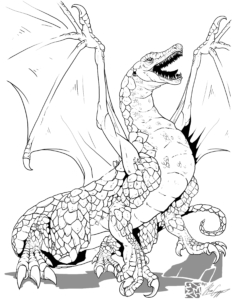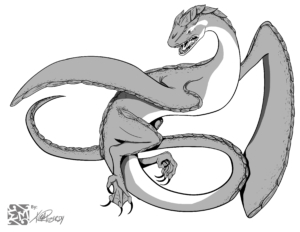
Dragonensis dragonis fuscus magna
From Homo transformans: The Origin and Nature of the Species
Illustration by Epic Made
Class: Mammalia
Family: Dragonidae
Genus: Dragonensis
Species: Dragonis
A Fearful Cry
A great gray dragon heard the fearful cry of the lynx and wondered at it. He was keeping watch over his terrain when he heard the lynx’s cry. Soon, a high mountain crag shuddered and shifted, yet no stones fell. The dragon, perfectly blended into the mountain, lifted off. He immediately set forth to search for the cry’s source. Something dangerous and deadly had entered his domain.
A pair of dragon chicks, perched on the ledge of their aery, also heard the cry. They too became alert and looked toward the sound. Their mother abruptly called to them from the cave that housed their nest, and they promptly scurried inside. Then, the dragoness positioned herself at the entrance to her cave. There she watched and waited—her deadliest weapon at the ready.
(Excerpt from H’Ilgraith, Sister of the House of H’Aleth, planned release January 2020.)
Introduction
The novel Homo transformans: The Origin and Nature of the Species introduces three species of dragons. Two, in particular, play a pivotal role in the outcome of the story: Dragonensis dragonis fuscus magna, a great gray dragon, and Dragonensis dragonis rubra, a red dragon. The story is unique in its treatment of dragons as mammals, creating an ancestry and biology of the dragon genus and species which is predicated on mammalian characteristics.
Characteristics of Mammals
Animals are classified as mammals according to four primary characteristics. These are 1) being warm-blooded (homeothermic) (Grigg, et al., 2004), 2) having hair or fur (Martin, et al., 2015), 3) having three middle ear bones (ossicles) (Anthwal, et al., 2013; Mason, 2013), and 4) nursing offspring with milk from mammary glands (Oftedal, 2012). The development of ossicles in the middle ear is also linked to the development of the hinged jaw, another characteristic of mammals. Additionally, a mammal’s eyes are positioned on either side of the head and face forward (for overlapping visual fields) to allow for stereoscopic vision (Nityananda & Read, 2017). Powered flight (versus gliding) is not a characteristic of mammals. Bats are the only mammal known to fly. (Flying squirrels are gliders.)
There are three broad classifications of mammals. They are:
1. The monotremes (prototheria), which lay eggs to produce their young (duck-billed platypus, echidnas). They do not have teats; however they do have mammary glands that produce milk.
2. The marsupials (metatheria), which produce very immature young and rely on pouches to complete their development (e.g., kangaroos, koalas, opossums, et al.). They have teats within the pouch from which their young can suckle milk.
3. The placentals (eutheria) – all other mammals which rely on a placenta, which connects the blood supplies of both the mother and fetus, to support the fetus in the womb (in utero). Placentals also have teats to suckle their offspring.
The common ancestor of the mammalian clade (the eutriconodonts) dates back to the mid Jurassic period. Monotremes are the oldest mammals. They are followed by the development of marsupials and subsequently placental mammals. Placental mammals are by far the most common. There are only five surviving species of monotremes – the duckbilled platypus and four species of echidnas.
Dragona
In the story Homo transformans: The Origin and Nature of the Species, fire dragons are treated as mammals and classified as monotremes. They lay eggs from which their young are hatched. The chicks can climb onto the mother’s abdomen, where they lick the milk released from mammary glands that open onto the surface of the mother’s abdomen. All species of dragons are capable of producing their own heat (endothermic), and regulating their own body temperature (homeothermic). This includes marine dragons (e.g., Dragonensis odontoceti) and other aquatic dragons (e.g., Dragonensis dragonis alba).

Dragonensis odontoceti
(From H’Ilgraith, Sister of the House of H’Aleth)
Illustration by Epic Made
Although dragons have a protective layer of overlapping plates or scales on their bodies, they also have a thick coat of dark, very fine “downy” hair (lanugo) which cushions the plates and scales and prevents them from rubbing against the skin. Lanugo also offers insulation against the harsh, cold winds and temperatures encountered at higher mountain altitudes, in ocean depths, and in arctic waters.
Dragons are the mammalian equivalent of a raptor. Their large chest supports the massive muscles necessary for powered flight in an animal as large as a dragon. The wings of terrestrial dragons have no scales. Marine and aquatic dragons have very thin scales which they can compress tightly to become water-proof. Dragon skin has a leathery texture which provides both strength and elasticity. When applied to wings, these characteristics provide the flexibility needed for powered flight. The lanugo on a dragon’s wings is longer than on the rest of the body. It both insulates the wings and acts like feathers. Minute muscles in the skin raise and lower the hairs.
Dragons have no external ears; however, they do have an auditory canal which transmits sound to the middle ear. The middle ear has three bony ossicles adapted to low frequency hearing consistent with how dragons communicate. All species of dragons have a hinged jaw and razor-sharp teeth consistent with a carnivorous species.
Like most mammals, the eyes of a dragon are positioned forward on either side of the face to allow for stereoscopic vision and good peripheral vision. By design, this allows a visual field of about 180 degrees in any one direction. Since dragons have relatively long necks, they can turn their heads in a wider arc to expand their visual range. This facilitates their search for prey and predators.
The source of a fire dragon’s fire will be posted next week.
References
Anthwal, N., Joshi, L., Tucker, A. S. (2013.) Evolution of the mammalian middle ear and jaw: adaptations and novel structures. J Anat, 222(1), 147-60. doi: 10.1111/j.1469-7580.2012.01526.x.
Grigg, G. C., Beard, L. A., Augee, M. L. (2004.) The evolution of endothermy and its diversity in mammals and birds. Physiol Biochem Zool, 77(6), 982-97.
Martin, T., Marugán-Lobón, J., Vullo, R., et al. (2015.) A Cretaceous eutriconodont and integument evolution in early mammals. Nature, 526(7573), 380-4. doi: 10.1038/nature14905.
Mason, M. J. (2013.) Of mice, moles and guinea pigs: functional morphology of the middle ear in living mammals. Hear Res, 301:4-18. doi: 10.1016/j.heares.2012.10.004.
Nityananda, V., and Read, J. C. A. (2017.) Stereopsis in animals: evolution, function and mechanisms. J Exp Biol, 220(Pt 14), 2502-2512. doi: 10.1242/jeb.143883.
Oftedal, O. T. (2012.) The evolution of milk secretion and its ancient origins. Animal, 6(3), 355-68. doi: 10.1017/S1751731111001935.